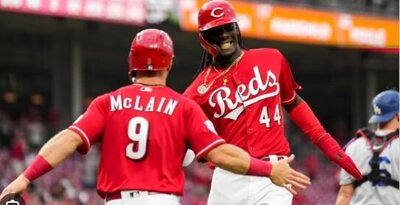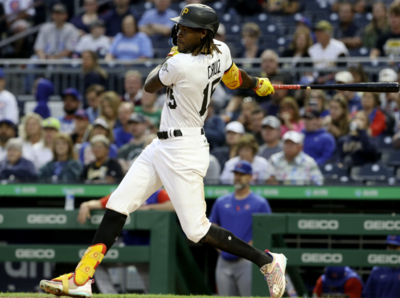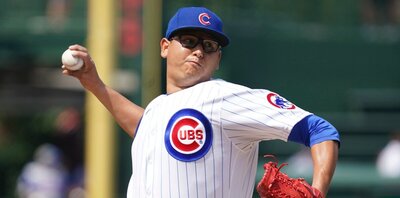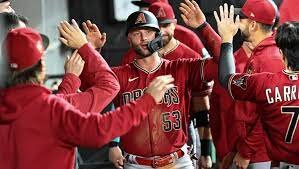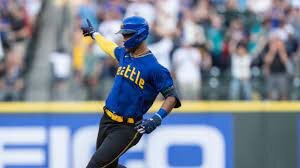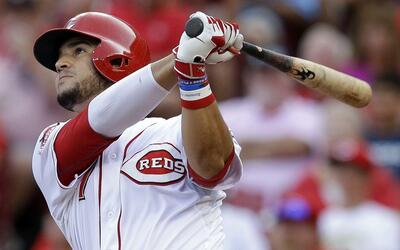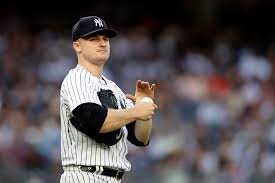Mike Trout (OF - LAA): When I wrote back on May 21st that I thought Mike Trout was a Top 15 OF the rest of the way, I thought I was being bold... Instead, it turned out I was pretty light on my prediction as Trout hasn't just been a top 15 OF, but he's been the best player in all of fantasy. With Trout missing a full month of the season, being only 20 years old, and having climbed all the way to the #1 overall player fantasy owners are wondering what the implications are for his future draft position. The two statistics that the analysis centers around tend to be Trout's power and his batting average, which is being generated by a .400 BABIP; so let's dive in on those two. Let's start with the power, which Lou Blasi and Jason Collete challenged me on back in May when I said I thought Trout had 25 HR power - IN HIS PRIME. Most scouts thought Trout's power could reach those levels, but was more likely to settle in around 20 HR power. After 82 games in the big leagues Trout has already hit 18 HR's, producing at a rate even the biggest Trout fan (which I consider myself) wouldn't have imagined in his rookie year let alone his prime. Trout's .252 ISO is above anything he's posted at any minor league level (previous high .221 in AAA this year). Trout's 20% HR/FB Rate looks a bit elevated for a player of his stature (and age) but looking at home run tracker just 3 of the 18 HR's have been classified as "just enough", which happens to be the same number of "no doubters" he's racked up. In fact his average true distance of 406.5 ft is above the league average of 398-399 ft. All this is to suggest that any step back in Trout's power would likely be modest (if at all) and likely mitigated by his body continuing to mature. As scary as it may be, the power looks pretty legitimate... how about the BABIP? Well in a vacuum a .400 BABIP seems ridiculous, but if you look at Trout's minor league career you'll see BABIPs of .423, .444, .420, .346, .347, .390, and .476. Players posting elevated BABIPs in the minor leagues aren't unusual (fields are in worse condition, caliber of defenses also much worse), but to see a couple partial seasons in there with .400+ BABIP's is a sign that an extremely elevated BABIP for Trout isn't out of the question. Now can he maintain a .400 BABIP? I don't think so. But his 25% LD Rate suggests an expected BABIP around .370 and even if that LD Rate reduces a bit Trout's tremendous speed will likely keep his ground ball BABIP elevated compared to peers. A career .342 hitter in the minor leagues, is it really that ridiculous to see him hitting .347 in the majors? His true level of talent probably lands somewhere between .320-.340, but the point here is that elevated batting averages are probably a legitimate part of the package for Trout. So what are my expectations for next year? Well, it's hard for me to see him as anything but a Top 5 pick and a potential #1. If we project Trout's current pace out over a 150 game schedule we'd get: .347-149-32-99-59. If we take a huge reduction (say 25%) to the counting totals and normalize the batting average we're looking at something like .325-112-24-74-44. To give a comparison our preseason projection for Ellsbury was .301-108-26-84-41 and he ranked as a back-end top 10 pick. Given we're reducing Trout's performance by 25% and he's still coming out as a Top 10 pick with his actual production ranking as #1, I think the 20 year old will be my preferred #1 pick next year.
Carl Crawford (OF - BOS): As someone who was very high on Carl Crawford coming into the year (and have been throughout his career), the 2012 season could not have played out much worse. Crawford's spring training injuries turned out to be far worse than anyone anticipated pushing his return back to July and even when on the field the performance has been anything but vintage Crawford. Crawford's 2011 season was torpedoed by some pretty significant deterioration in his plate discipline and that has not only continued in 2012, but gotten worse. Crawford's swinging strike rate has climbed to 9% and his K Rate overall is now above 20%. For a player who depends on his speed for much of his fantasy value, the inability to put the ball in play has had a severe drag on his batting average, his on-base percentage, and thus his ability to steal bases. A sub-.280 BABIP is exaggerating things a bit as Crawford is probably more of a .260's-.270's hitter with these K Rates than a .240's, but the deterioration in skills is meaningful nonetheless. Along with the statistical risk that Crawford now carries, the fact that he knowingly needs elbow surgery and could shut it down at any moment this year brings even more concern. The optimist in me wants to believe Crawford can regain his elite value, but the analyst in me is seeing three straight years of expanding chase rates and declining BB Rates that paint a pretty compelling picture that Crawford isn't the same player.
Jon Lester (SP - BOS): Perhaps with the calendar turning to August we can get back to seeing some of the old Jon Lester. After an abhorrent July in which Lester posted a 9.36 ERA and an almost impossible to believe 6.76 FIP, Lester got August started right with a solid 8-inning performance against the Twins. Lester struck out 8, walked none, and kept the ball in the park thanks to a 62% GB Rate for the outing. This is important because as Schuyler noted last week Lester's GB Rate plummeted in July (37%) after having been consistently between 48-49% the first three months of the season. In those first 3 months Lester's xFIP was pretty much in-line with his 3.73 career rate, but even then there were some indicators that things weren't quite right and it was flowing into the results. Lester's LD Rate allowed remained elevated through the first 3 months (23%, 17% previous 3 years) and Lester's HR/FB Rates also remained elevated. Pitch f/x data suggests Lester has used his cutter a lot less this year (perhaps explaining the rise in HR/FB Rate) but from looking at the movement data it's hard to decipher whether that's legitimate or classification error. It's easy to just assume from Lester's increased HR/FB Rate and LD Rate this year that his stuff is down, but the swing data doesn't really support it. Lester's swinging strike rate is right in line with his performance last season (8.6% this yr vs. 8.7% last year) and his chase rate has expanded very modestly (31.3% vs. 30.5%). All the other swing data, contact rates inside and outside the zone, look pretty similar to the 2011 version of Lester that went 15-9 with a 3.47 ERA and 1.26 WHIP. Similarly while many have pointed to a drop in velocity for Lester his avg FB of 92.6 mph is just .2 behind his 92.8 mph last year and actually .1 ahead of his 92.5 mph career avg FB velocity. What does this all mean? My take is Lester's location and command have been off this year and hitters have been able to tee off on pitches catching the heart of the plate as opposed to the corners. This leads me to believe Lester remains a solid buy-low candidate and someone I'll likely end up with on a lot of teams next year.
Dan Straily (SP - OAK): Just a day after the Rangers announced the promotion of top prospect Mike Olt, the Athletics countered by promoting one of their own: Dan Straily. Straily's numbers in the minor leagues this year are something out of a video game. He's struck out 175 in 138 1/3 innings of work while posting a 2.60 ERA and 0.97 WHIP, including a 1.36 ERA and 0.77 WHIP in a notorious hitters league the PCL. Straily wasn't considered an elite prospect coming into the season, but his stuff has improved this year with his fastball working 90-94 mph and positive reports on his slider, curveball, and changeup. The improvements have played out in the results and many scouting services have started to upgrade their projection for Straily from back-end starter to mid-rotation starter with #2 upside. He ranks as David Regan's #34 pitching prospect. Given Straily's dominance at AAA and the glowing reports about his command and 4-pitch mix, it's hard to imagine Straily struggling in the pitcher's haven that is the Coliseum. The bigger question is what do the A's plan to do with a bevy of arms on the way? Brandon McCarthy will make his 2nd scheduled rehab start on Saturday and he'll be followed by Brett Anderson making his 3rd rehab start on Sunday. Anderson is still building up his pitch count so he appears a few starts away, but McCarthy could be ready as soon as next week (in fact that is what our Lyle Logan is projecting). When McCarthy is ready the A's would have Colon, Straily, McCarthy, Milone, Griffin, and Parker for 5 spots (with Anderson on the way as well). The A's seemed reluctant to move Colon at the deadline, but he would appear to be the weak link and has at times worked out of the bullpen in the past. So is tonight's start an audition for the rotation long-term or is this a spot start? While battling that question I labored to the waiver wire and ultimately missed out on Straily in a number of ten team leagues. I do think he'll be successful in the start against Toronto, but I question the spot long-term and as a result would be careful who I was dropping before adding. If guaranteed a rotation spot the rest of the way I could see Straily having very similar levels of success to what AJ Griffin has had.
Ryan Dempster (SP - TEX): Many of our analysts have been predicting Dempster's regression for some time and when his new home address not only switched leagues but switched to one of the more challenging parks in all of baseball, the timetable of those predictions started to shrink. On Thursday night Dempster's debut proved many of the analysts' right as he struggled against one of the best offenses in all of baseball. Dempster allowed 8 ER's on 9 hits and 3 BB's and was able to get through just 4 2/3 innings. While Dempster struggled there were some positives to take away from the outing. The 24% K% Dempster posted in the start shows his stuff will still miss bats in the AL and a 14% LD Rate allowed in the game wasn't terrible. His 50% FB Rate allowed was pretty concerning and the XBH's that those FB's generated along with the control issues (12% BB%) really did him in. Dempster posted a 44% GB Rate in the NL and the 35% he posted last night left him very susceptible to the long-ball - something Dempster had done a great job avoiding this year. Looking ahead it's fair to expect Dempster to pitch more like the 4.00 ERA, 1.32 WHIP pitcher he's been the last few years along with a bit more W potential thanks to the Rangers lineup (who scored in double figures again on Thursday). Hopefully Dempster built up a strong enough lead for his owners in the ratio categories that they can afford a step back there in pursuit of some W's.
Follow us on Twitter all year: @Fantistics and @drewdinkmeyer
These are only a few of the players we are covering today. We profile over 100 players everyday in our premium section, become a member today.

